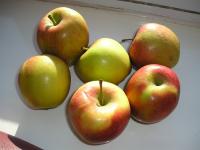Winter Pruning of an Established Apple Tree

How to prune an established apple tree for a successful crop.
This week I have been pruning apple trees. My primary aim when pruning established apple trees is to produce a good crop of quality apples. The careful management of the tree’s fruit baring buds achieves this.
In days gone by, pruning at this time of year would also have been to try and control a tree’s vigour. But that purpose is largely redundant these days with the introduction of the different dwarfing root stocks, which dictate an apple tree’s height and vigour.
Before you start to prune your established apple tree (pruning of young, newly planted apple trees is separate subject all together) it is important to confirm if the apple variety you have produces fruit along the branches on fruiting spurs. Or it may be a tip barer; the fruits being clustered on branch tips. Some apple varieties do both.
I think the most important thing to remember with any pruning of apple trees is to learn to hold back from any excessive, vigorous pruning. Such pruning simply encourages lots of non-fruit baring vegetative growth. It is much better to be a hairdresser than a butcher when pruning apple trees!
As with any pruning the first job is to remove any dead, diseased or dying wood. Also remove any branches that have been damaged by rubbing one against the other.
Winter Pruning of Spur Type Apple Varieties
The aim with these varieties is to encourage the development of fruiting spurs and they need to be equally spaced along each branch. They must not be allowed to become too numerous and congested.
- So, at this time of year begin by shortening any lateral shoots along the branches to 3 or 4 buds long.
- Assess the vigour of the leading shoot from each branch, if it is very weak prune it by up to two-thirds, just one-third if it a strong example.
- If it looks as if there are too many spurs, too congested with little space between each one then it is important to be ruthless. Try to imagine each spur as a full-sized apple and the space each apple would need around it to prevent bruising. It is much better to have a few good spurs, nicely spaced, producing good quality apples than a bumper crop of inedible miniature apples.
It is also important to thin out congested spurs for the general health of the tree. Such pruning lets more light and air into the branches, reducing the likelihood of pests and diseases.
Tip Baring Apple Varieties
Varieties in this group produce fruit on the tips of young shoots. With these varieties the aim of the winter pruning is to encourage more young shoots.
- Any short lateral shoots should be left unpruned, the aim being for these to develop and grow into tip barers in subsequent years.
- Again assess the vigour of any long leading shoots and prune appropriately.
Time spent on a step-ladder amongst the branches of an established apple tree, freezing fingers and toes that you can no longer feel, it will all be but a distant memory when you are enjoying your crop of quality home-produced apples next autumn.
Useful Resources
Filed under DIY Gardening Jobs.

